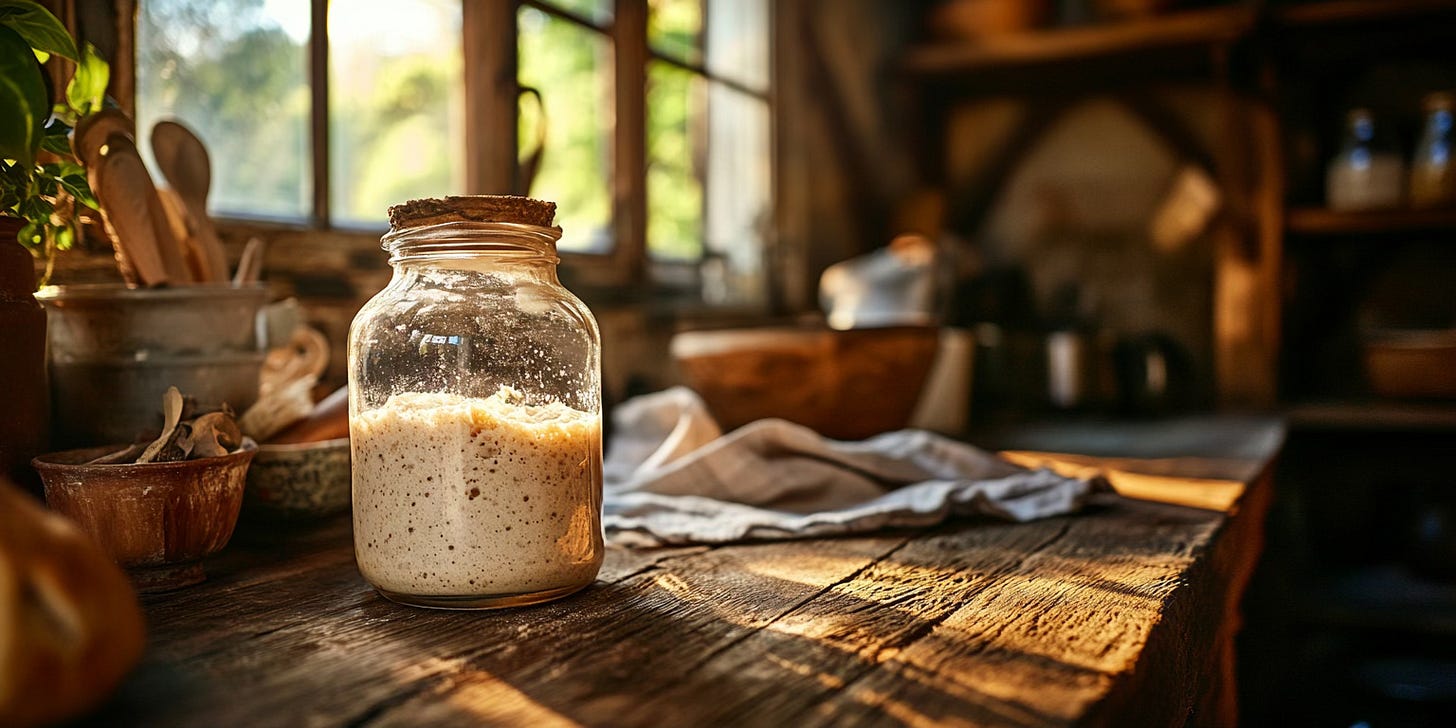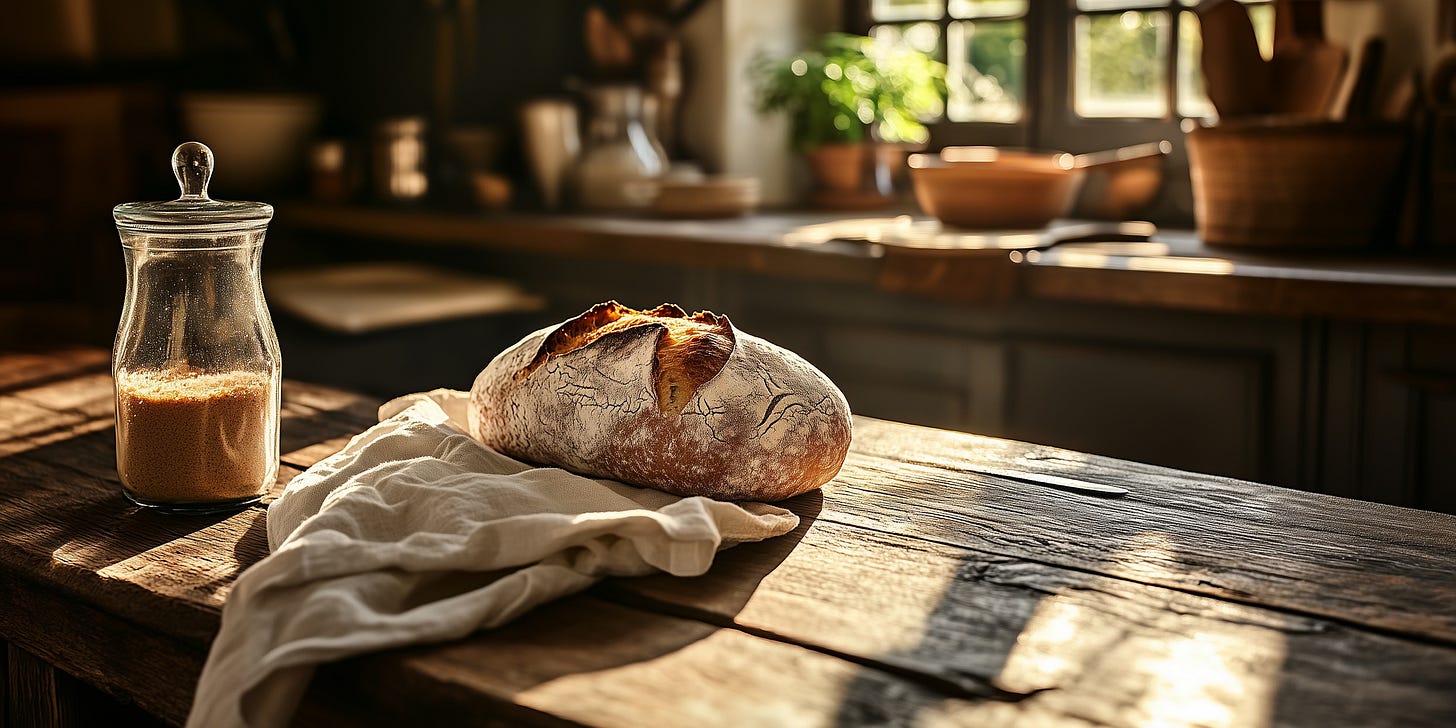Sourdough Basics
Why sourdough? Superior flavor, health benefits, natural ingredients, culinary artistry, or being part of a community. The reasons are many to baking with sourdough!
Baking with sourdough is the original way of baking—it’s how bread was made long before the invention of isolated commercial baker’s yeast. In fact, baking with sourdough has been practiced for more than 5,000 years!
"One of the oldest sourdough breads dates from 3700 BCE and was excavated in Switzerland, but the origin of sourdough fermentation likely relates to the origin of agriculture in the Fertile Crescent and Egypt several thousand years earlier" 1
But why would you bake with sourdough today? Bakers yeast is widely available and easy to use. Are there really any good reasons to go through the process of using sourdough? If you ask me yes! And many others keep the old tradition alive and for good reason. There are in fact many reasons to hold on to and continuously nurture your bubbling sourdough starter.
My primary reason is the superior taste. Sourdough’s longer fermentation process releases natural sugars and develops flavors that quick-rise breads can’t match. The more complex taste of sourdough bread is reason enough to put in the extra effort.
Another compelling argument is that sourdough bread is known to be healthier. The fermentation process pre-digests the fibers and proteins in the dough, which commercial yeast doesn’t achieve. To put it simply, the microorganisms in sourdough do some of the work that your stomach would otherwise have to do, making the nutrients more accessible for your body to absorb.
Understanding the basics of sourdough
At its core, sourdough is a living culture made up of two key types of microorganisms: wild yeast and lactic acid bacteria. These microorganisms naturally live basically everywhere in our environment, but in sourdough they come together to process the proteins and fibers in the flour and ensure the natural rise of the bread.
The Role of Wild Yeast: Nature’s Leavening Agent
Wild yeast is the unsung hero of any sourdough bread. Unlike commercial yeast, wild yeast is naturally present on grains, in the air, and even in your kitchen. In a sourdough starter, it thrives by feeding on the sugars in flour, producing carbon dioxide gas that gives the dough its rise and airy texture.
What makes wild yeast differ from baker’s yeast is its slower fermentation process, which allows flavors to develop more deeply over time. Every sourdough starter has its unique blend of wild yeast, influenced by your environment, making each loaf of sourdough truly one of a kind.
Lactic Acid Bacteria: The Flavor Builders
Lactic acid bacteria are the flavor architects of your sourdough bread. These beneficial microorganisms coexist with wild yeast in the starter, contributing acidity and complexity to the bread. By converting sugars into lactic and acetic acids, they give sourdough its signature tangy taste and subtle aroma.
Beyond flavor, these bacteria improve the bread's nutritional profile by breaking down complex compounds in the flour, making sourdough easier to digest. They also act as natural preservatives, extending the bread’s shelf life without the need for additives.
A Perfect Partnership
The lactic acid bacteria and the wild yeast go together in a perfect harmony. The bacteria creates an acidic environment which is hostile to many other microorganisms leaving the sourdough stable and safe from harmful contamination. As the bacteria do what they do the resulting acids accumulate, which lower the pH of the sourdough, making it more acidic. A healthy sourdough starter typically has a pH in the range of 3.5 to 4.5, which is too acidic for most harmful bacteria or molds to survive.
The wild yeast however has no problem with this acidic environment, which gives it plenty of room to develop and create gases, now that any competition is out of play.
This harmony between wild yeast and bacteria is what sets sourdough apart from other types of bread, both in taste, quality and natural preservation.
The sourdough starter
So, you’re excited about baking sourdough and ready to take the next step? It all begins with one essential element: the sourdough starter. This living culture is the heart of sourdough baking, and once you establish it, you’ll have a lifelong baking companion.
How to create your own starter
A sourdough starter is a simple mixture of flour and water that naturally captures wild yeast and lactic acid bacteria from the environment. Over time, these microorganisms multiply, creating a bubbly, tangy, and active culture that will help your bread rise naturally.
Making a sourdough starter from scratch is surprisingly simple. All you need is flour and water.
The flour
For your starter I recommend using whole wheat or rye flour for starting, as they contain more natural wild yeast and nutrients. The flour you use for your starter will not limit you in your future baking endeavors. For every baking you will prepare your starter with the relevant flour for that specific bake.
If possible, you should opt for organic flour. From my experience the organic flour will more easily and faster help you establish a working starter culture.
The Water
Use non-chlorinated water as chlorine can inhibit yeast growth.
Also, use water a room temperature. The bacteria and yeast strains that we want to promote thrive best at temperatures above 22 degree celcius. Adding cold water would slow down the process and potentially allow unwanted fungi or bacteria to take over your starter.
Step-by-Step Guide to your sourdough starter
Day 1: Mixing the Starter
In a clean jar or bowl, mix 50g flour with 50g water until smooth.
Cover loosely with a lid or cloth and let it sit at room temperature (22-25 degree celsius) for 24 hours.
Days 2, 3, 4, and 5: Feeding Your Starter
Each day, discard half of the mixture to prevent excessive buildup.
Add 50g of fresh flour + 50g of water and stir.
Keep it at room temperature and watch for bubbles and a slightly tangy smell.
Day 4 or 5: Active and ready
Your starter should be bubbly, slightly risen, and have a pleasant, slightly sour aroma. If it’s active and doubles in size within a few hours after feeding, you’re ready to bake!
If your starter is not yet active at this point, then continue feeding for a few more days.
Congratulations on making it this far! You now have an active starter and you are now ready to start baking wonderful sourdough bread.
How to care for your sourdough starter
A sourdough starter is a living culture, and like any pet, it needs regular feeding and care. Here’s how to keep it strong and active.
Baking often
(Every day or every other day)
If you bake daily or every other day, keep your starter at room temperature and feed it once a day. Always discard half and feed with fresh flour and water (1:1 ratio). The amount of flour and water that you add when feeding must match the amount needed for the recipe of your planned baking.
For a basic 1kg bread, I usually prepare a total 250g of starter. I do this by feeding my existing starter (50g) with 100g water and 100g flour. This works for my specific recipe, but you will need to adjust according to your needs while also remembering that there must be some starter left over to feed and save for future baking.
Baking less often
(Once a week or more rarely)
If you bake once a week or less, you can keep your starter in the fridge. Feed it once a week to keep it alive. When feeding it you just take it out of the fridge, discard half, feed it, let it sit for an hour, and return it to the fridge. When ready to bake, take it out and feed it for 1-2 days before using.
Ready to bake!
With proper care, your sourdough starter will remain active and strong for years, providing you with delicious, healthy, naturally leavened bread whenever you want to bake. Whether you keep it at room temperature for daily use or store it in the fridge for occasional baking, maintaining a healthy starter is easy and rewarding.
Now that you have your starter, are you ready to bake your first sourdough loaf?
Gaenzle, Michael (1 April 2014). "Sourdough Bread". In Batt, Carl (ed.). Encyclopedia of Food Microbiology (2nd ed.). Academic Press. p. 309. ISBN 978-0123847300.



